

Jim Huether interview
By Scott Stilphen
(2007)

Jim got his start in game design on the venerable Atari VCS, giving us Flag Capture, Sky Diver, and Steeplechase. He then moved to the 5200 and programmed the impressive RealSports Football - arguably that system's best sports title. His career after Atari was just as successful, as the producer of several titles for the Sega Genesis, and later as Technical Director for Saturn peripherals. He was also immortalized on the packaging for another classic Atari game. Jim's a true virtual gridiron hero... or warlord if you prefer ;)
Q: Whatís your educational background?
Jim Huether: I have MSEE and BSEE degrees from Rice University.
Q: Did you work for anyone prior to Atari (after school)?
Jim Huether: Yes, I worked as a Senior Software Engineer at GTE-Sylvania, designing and writing real-time signal processing software for DOD contracts.
Q: What inspired you to go into game design?
Jim Huether: I was looking to change jobs and saw an ad for a Game Designer/Programmer at Atari. For years I had wanted to make things come alive and animate on a computer.
Q: Were there any programmers or games that inspired you?
Jim Huether: Once I got to Atari, almost all of the game designers and even some of the hardware designers inspired me.
Q: How did you hear about Atari? When did you start working there?
Jim Huether: I had heard about Atari from the coin-op Pong game. I saw an ad in the paper and I started there in late 1977.
Q: What was the development process like?
Jim Huether: The development process consisted of a document that described the Stella chip, a 6502 processor manual, a few short memos, and a development/debug station. We were basically told to do a game in 6 months. It didnít matter what hours we chose to work.
Q: What was it like working there?
Jim Huether: The hours were whatever we wanted them to be. We could even work totally at home as long as we got a working game done by a deadline. In reality, it was good to come in to Atari and work, because there were people who could help with programming questions, and give design and game play advice. It was also fun to be there. Nolan Bushnell had created a great environment. We worked hard, and played hard.
Q: Were the titles you worked on assigned, or chosen by yourself?
Jim Huether: Almost all of the titles I did were ones that I chose by myself. During my final years at Atari in 1983 and 1984, I was assigned to do the game Xevious on the 5200.
Q: Did you work with any graphics or sound artists? If so, do you recall who helped with what?
Jim Huether: Initially there were no graphics or sound artists. We did the graphics and sounds ourselves. Once I went with Owen Rubin into a restroom and we threw wet balled up paper towels at the wall and recorded the sound patterns into a storage scope. I ended up using one of those for many sounds in Steeplechase and Sky Diver. I could modify the sound by how often I sampled it in the program, the frequency I sampled it, and the volume I used. Later on the 5200, I worked with our first graphics artists, Marilyn Churchill and Alan Murphy, who were both canvas artists in their own right.
Q: Tell us about the games you did Ė how long each took to develop, what problems/obstacles you encountered during their development, etc.
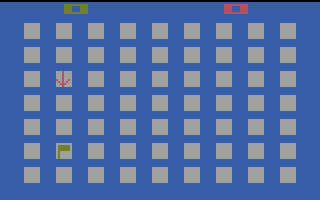
Jim Huether: Flag Capture: This was the first game I did for the 2600, so it was a big learning experience. It was difficult to do a game in 2K bytes of ROM, 128 bytes of RAM including the stack, and writing to the screen on the fly. I wanted to do something like Stratego, but realized I couldnít do it on a single screen. So I turned it into a 'capture the flag' type of game. It took about 6 months to complete. The graphics were pretty bad, but the game play was very good. Steve Stone, a chip layout guy at Atari, really liked the game and gave me some ideas for the variations in game play. It was sort of a cult game, in the sense that people either really liked and were addicted to it, or else they didnít like it because the graphics were bad or they couldnít understand the more complicated levels. It was a great two-player fast-action game, though.
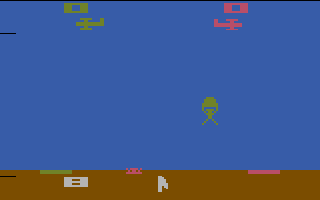
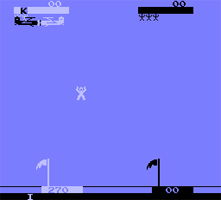
Atari VCS Sky Diver (LEFT); Atari coin-op Skydiver (RIGHT)
Sky Diver: This game also took about 6 months as I recall, and I started it before I even knew there was a Skydiver coin-op game. About midway through the development I found out about Owen Rubinís game, and got a chance to see and play it. Because the 2600 had much less power than the arcade machines, there were things that I could not do as well. However, since we could select multiple game variations on the 2600, I ended up having more types of game play. This was the best-selling 2600 game until Space Invaders came out.
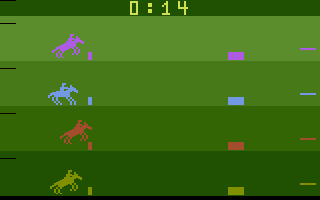
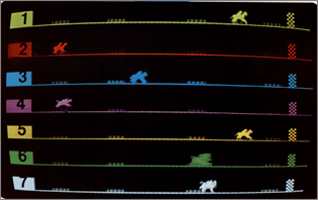
Atari VCS Steeplechase (LEFT); Atari coin-op Steeplechase (RIGHT)
Steeplechase: I did this based on the coin-op game, but again the 2600 had much less power. I was able to make it a 4-player simultaneous game however. I ended up using only 5 or 6 graphics cells for the horse animations, but they worked very convincingly in that era. People would play the game and have empathy for their horse when it would hit a gate and fall. Also, this was one of the first games that females played as much as males. This game took about 4 or 5 months as I recall.
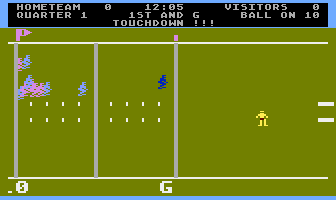
RealSports Football (5200): This game took almost a year. It was my first real game on the 5200, and one I had wanted to do ever since I started at Atari. I remembered that vibrating football game product from when I was kid, and I wanted to make it come alive on a computer. I essentially did this entire game by myself also, including the design, the programming, the animations, the sounds, and even the draft of the manual and the play card. I did have a bit of programming assistance by Dave Staugas near the end for a few routines, such as moving the chains on first down, etc., and I had a few graphics done for final touches by our graphics artists. This game used artificial intelligence, so all the players on the field were tasked with roles at the beginning of the play; as the play developed, they would change their roles as necessary, just like in real football. The Stanford football team was hooked on this game, and I got to demonstrate it and play it for about 15 minutes with Steven Spielberg when he came to visit.
I do have to thank Mike Alba, who was one of our coin-op designers. He had done the popular arcade top-down football game with Xs and Os, Atari Football. He let me look at some of his code with him, so I could use that knowledge to adapt to my game for the real-time re-tasking of the players on the field.
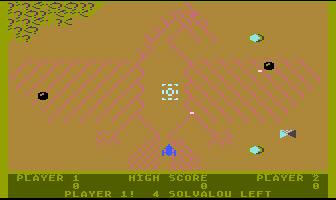
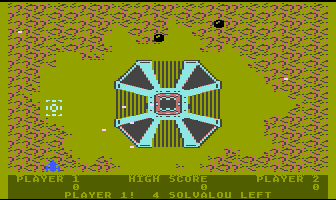
Xevious (5200): This game was the first where I used a graphic artist, Alan Murphy, during much of the development time - since this game was very rich in graphics, I needed a real graphic artist. It turned out beautiful. Also, Tod Frye and myself went to Tokyo to visit Namco. While there, we were given the source code to the Xevious arcade game and we actually sat with the designers of the game, and by pointing to tables and other code in printout, and by using common programming terms of the time such as ďjump tableĒ, we were able to understand the basic design and graphics of the game. From there, we worked on our games pretty much separately.
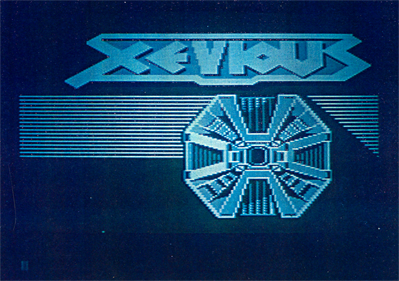
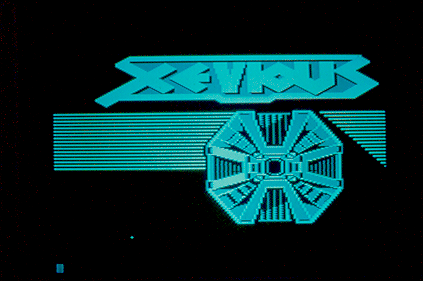
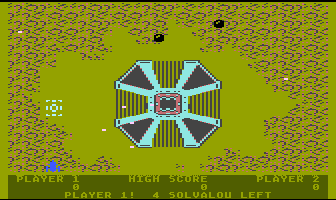
Examples of Xevious title screens created by Alan Murphy, a variation of which
was very likely intended to be used in the final version of the game.
Q: What are your thoughts on the Windows game, Minesweeper? One could argue that itís a descendant of Flag Capture :)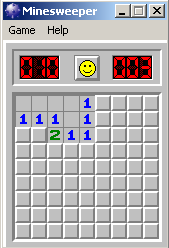
Jim Huether: I really never played Minesweeper, so I canít comment. If it was based on Flag Capture, then as they say, imitation is the sincerest form of flattery.
Q: How did you come to port an older Atari coin-op game like Steeplechase? And why/how did it end up being a Sears exclusive title?
Jim Huether: I liked the game, and decided I could do it on the 2600. It turned out to be a lot of fun as a multi-player game. That (Sears exclusivity) was a business decision over which I had no control. I believe Atari had an agreement with Sears to have a certain number of games each year be exclusive Sears titles.
Q: Did you and Rob Zdybel collaborate on your respective versions of RealSports Football?
Jim Huether: There was no collaboration with the football games. In fact, Robís 2600 game was started much later after I started the 5200 game. The 2600 just did not have the power to do the AI and the horizontal scrolling view that I did on the 5200.
Q: Xevious is a very faithful version of the coin-op, right down to the giant bird geoglyph. A number of versions have been found but was the game ever completed?
Jim Huether: It was ready for release, but it got held up when Atari started going through some real internal turmoil. Then at one point, they asked me to change it to Dune. That was ridiculous, and by that time, I was fed up with the way Atari was changing, so I asked to be laid off, and they finally agreed in June of 1984, just before Jack Tramiel bought the company. At the time, the coin-op Xevious was being touted as the game youíll never be able to play on a home system.
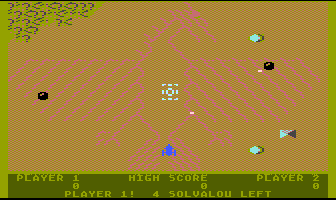
Xevious arcade flyer for operators touting it being the game you can't play at
home.
Q: For a time they were right, since Todís VCS version was never released either, or even completed for that matter. It wasnít until a version for the 7800 system came out in 1986, but even that almost didnít make it out, since it was basically done in 1984 and then shelved while Atari changed ownership. Although RealSports Football was eventually released for the computers (in 1987), your Xevious never was. Was there a plan to port this to the 400/800 at the time?
Jim Huether: Not that I was aware of.
Q: Were there any other titles you worked on?
Jim Huether: When the 400/800 computers were first developed, I worked on an animation/cartoon maker type of product. I did 2 versions, one code-named Micro Movie and the other Micro Flick. They worked and were releasable, but Atari decided not to market them, because they were not either games, business software, or educational software in their eyes. I ended up using one of them to test out animations for my 5200 games. I believe they were the first real 'full feature' animation tools ever developed for a personal computer.
Q: You also helped out with VCS RealSports Volleyball, correct?
Jim Huether: I helped Bob Polaro come up with the basic concept. He and I used to play beach volleyball in Capitola Ė usually while drinking vodka and oj. I also helped him design the screen driver/kernel. However, Bob did the rest of the game. Itís totally his game, and he did a great job Ė I just helped him get started.
Q: With your games, were there any features you would have liked to added, or any known bugs or glitches that gave you trouble (or never got resolved)?
Jim Huether: There were always features I wanted to add, but either the system didnít have the capability or there wasnít time left in the schedule.
Most of my games were essentially bug-free. In fact, I had a bit of a reputation for that. There was one play in the 5200 RealSports Football that was un-defendable, once a person learned how to run the play a certain way.
Q: Do you remember what early or tentative titles your other games had (if any)?
Jim Huether: I didnít really use code names. The only ones were the unreleased Micro Movie and Micro Flick animation/cartoon maker titles.
Q: Were there any games or projects that you worked on that ultimately never got released or even finished?
Jim Huether: After I finished my last 2600 game, and since by then I was considered a senior game designer/programmer, I started doing some prototype display drivers to check out the potential new system that was code-named Super Stella. Myself and several others, including Rob Zdybel, decided the system just wasnít powerful enough to qualify as a next-level game system.
I then did some similar stuff on the 400/800 and the 5200.
Before I did the RealSports Football game for the 5200, I did the Micro Movie/Micro Flick titles I talked about above. I also had started a top-down, vertically-scrolling football game for the 2600 with little blocks as players several years before, but it got canned before it was done because the Mattel game came out and it had graphics that looked like football players.
Q: Do you recall any other titles that other programmers were working on that were never released, or finished?
Jim Huether: There were many, but I canít recall any specific titles.
Q: Besides Football, are there Easter eggs in any of your titles? Do you recall any fellow co-workers that put them in their games?
Jim Huether: Besides the 5200 Football game, I didnít really put any Easter eggs in my other games. As far as other peopleís games, Iíll leave it to them to tell.
Q: If you had a chance to redo any of your games, what would you change (if anything)?
Jim Huether: I donít know that I would change anything, except maybe fix that one un-defendable play in Real Sports Football. If I could have made the graphics better in Flag Capture and other games, I would have, but the ROM and RAM size and the display limitations did not really allow it. For the early 2600 games, we only had 2 Kbytes of ROM and 128 bytes of RAM, so not much room for graphics.
Q: Did you ever attend any industry shows, such as CES or Toy Fair?
Jim Huether: I attended CES twice a year while I was at Atari. I never went to the Toy Fair during those years.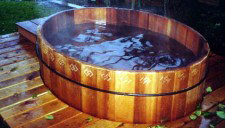
Q: What were some of your experiences working for Atari? Any stories or anecdotes from those days that you recall?
Jim Huether: LOTS! Way too many to mention. People can see and hear a lot of stories if they get a copy of the DVD Once Upon Atari by Howard Scott Warshaw.
Q: You also have the distinction of appearing on the artwork for VCS Warlords!
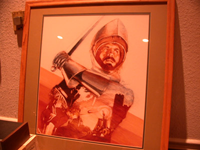
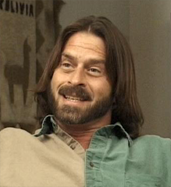
LEFT: original Warlords artwork. RIGHT: picture from 'Once Upon Atari'.
Jim Huether: The artist's name was Steve Hendricks. He took the photos and did the artwork. I still have the original full-size picture framed and on my wall.
Q: Can you talk a bit about your time in the industry after leaving Atari?
Jim Huether: I left Atari in June of 1984, just before Jack Tramiel took over. I then joined with two other colleagues from Atari, Jim Andreasen and Eric Manghise, at Advantage Software in Santa Cruz, to develop edutainment titles for the Commodore 64. I was the President of the company. I did not design or program the products we worked on; instead, I brainstormed and gave advice, but mainly I ran the company and devoted efforts to try to license the products to Publishers.
We had one title, I think called Puzzlemaster, that was a puzzle generator. It would cut a picture up into different jigsaw puzzle pieces, and then the user would have to click a piece and then click where they wanted it to go. They could rotate it in 90 degree angles to try to see if it would fit. We even had puzzles with multiple levels on top of each other. We never were able to release it, though. There was another product that I canít remember what we called it internally, but it was like a house where you could click on certain rooms and certain objects in the rooms, and then different animations related to that object would happen pseudo-randomly. It was meant to be a fun and educational title for little kids. We had one other product, but I cannot remember what it was.
We were self-funded and almost got two of our products picked up by EA, Epyx, and/or Spinnaker Software, but 1985 was a very bad year for the Commodore 64, and all the publishers were cutting back on third-party titles, so we didnít get anything licensed out, and eventually went and got real jobs.
Q: Since then, have you stayed within the field of game design?
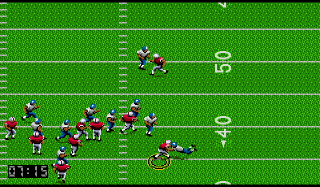 Jim Huether: I got back into games in 1988 when I became a Project Manager and then Senior Producer at Epyx until its demise in 1989. I then
went to Sega of America and became one of the first two Sr. Producers for Sega of America. I produced a number of games there including Joe Montana Football and Castle of Illusion starring Mickey Mouse. I'm aware that Roger Hector takes some credit for Castle of Illusion, but I donít recall ever having Roger Hector involved in that product.
The Sega design team was in Japan, and I dealt with them almost daily. I also worked with a Producer from Disney. His name is on the tip of my tongue, I think it was Stefan Butler. He was Disneyís guy in charge of making sure what we submitted as designs and then later working prototypes, met Disneyís criteria. I was definitely the man behind the super easy level for very young kids and their parents, as well as working with Sega Japan and Stefan at Disney,
and was the Producer. So maybe Roger was involved with Segaís Japanese design team behind the scenes.
Jim Huether: I got back into games in 1988 when I became a Project Manager and then Senior Producer at Epyx until its demise in 1989. I then
went to Sega of America and became one of the first two Sr. Producers for Sega of America. I produced a number of games there including Joe Montana Football and Castle of Illusion starring Mickey Mouse. I'm aware that Roger Hector takes some credit for Castle of Illusion, but I donít recall ever having Roger Hector involved in that product.
The Sega design team was in Japan, and I dealt with them almost daily. I also worked with a Producer from Disney. His name is on the tip of my tongue, I think it was Stefan Butler. He was Disneyís guy in charge of making sure what we submitted as designs and then later working prototypes, met Disneyís criteria. I was definitely the man behind the super easy level for very young kids and their parents, as well as working with Sega Japan and Stefan at Disney,
and was the Producer. So maybe Roger was involved with Segaís Japanese design team behind the scenes.
Also I was the Sega of America release Producer (by that I mean I took over as Producer somewhere in the middle of development and was the Producer that took the games to release) of James "Buster" Douglas Knockout Boxing and Pat Riley Basketball (both for the Genesis). I was also the Producer for Castle of Illusion and Joe Montana Football for the Sega Game Gear.
Since the Game Gear and the older Master System were essentially the same internal hardware, some of the Game Gear games were also released for the Master System, but I donít recall which ones. Eventually I became Director of New Product Engineering at Sega. My group was responsible for a few of the later Genesis peripherals, and most of the Saturn peripherals. Then Sega spun us off into SegaSoft. I stayed there as
Director of New Technology Development for about 7 months, where I drove the top-level spec for the initial Dreamcast design. SegaSoft then decided it needed to focus on software and not new hardware products, and so myself and my group were laid off. I havenít really worked for 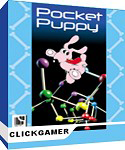 a games
company since, though I did independently produce the software for Pocket Puppy, a second-generation Tamagochi-like product for a company based in Hong Kong.
a games
company since, though I did independently produce the software for Pocket Puppy, a second-generation Tamagochi-like product for a company based in Hong Kong.
Until recently I was doing Program Management at companies such as Philips, for their multi-media software, and SDK, for their multi-media PNX processors, and also at Logitech doing Program Management for application, driver, and special effects software for their webcams. Now I am getting into doing Technical Recruiting, if you can believe that. I feel that with my experience as software engineer, technical manager/director, and program/project manager, I have the skills to be a successful technical recruiter for such positions.
Q: Do you still own any of your games for these systems, either as a keepsake, or to show friends or family?
Jim Huether: Yes, I do, but they are in storage now.
Q: Which of your titles are your favorite, and what types of games in general?
Jim Huether: Well I was always big on sports and racing games. I guess my favorite game that I designed and programmed was 5200 RealSports Football.
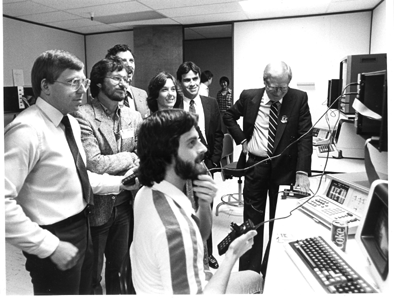
Jim demonstrating RealSports Football for Steven Spielberg, with George Kiss (behind him, far left) and Ray Kassar (far right).
Q: What are your thoughts on how the industry has evolved?
Jim Huether: Well I think the game play is no longer the main thing, as it was in the early days. There is a lot more focus on graphics and sound. Also maybe Iíve evolved, or just gotten older, but Iím not into the major platforms or PC games these days. I do occasionally play a handheld or mobile game to pass the time in an airport or on a plane.
Q: I donít know if you could ever see yourself getting back into the industry, but thereís still a (small) market for those classic 80s-style games. In fact, several 80s game designers (such as David Crane and Garry Kitchen) have drifted over into designing java and cell phone-based games.
Jim Huether: I considered producing cell phone games, but discovered that there were only a couple people at each of the major wireless carriers, who decided which games to allow to be downloaded into their phones, and I decided that market just wasnít open enough to get into. Also I would still rather play a game on a GBA or a PSP than on my cell phone.
Jim graciously allowed me to archive some of his
materials from his time at Atari and to
make freely available for everyone!
Source code listings:
800 "graphics package"
800 Micro Flick 5-29-80
5200 RealSports Football 8-6-81
5200 RealSports Football 8-6-82
Namco Xevious
1-7-83 (part of the code for the original arcade game Xevious given to
both Jim Huether and Tod Frye by Namco!)
Notes:
Jim Huether Dune notes
Jim Huether Xevious notes
Jim Huether Xevious obstacles lists
(first 2 pages were done by Alan Murphy)
Jim Huether Xevious sketches
Namco Xevious map - large
Namco Xevious map - small
Namco Xevious music notes
Namco Xevious notes (incomplete)
| GAME | SYSTEM | COMPANY | STATUS |
| Flag Capture | Atari VCS/2600 | Atari | released |
| Sky Diver | Atari VCS/2600 | Atari | released |
| Steeplechase | Atari VCS/2600 | Atari | released |
| RealSports Volleyball (helped with design) | Atari VCS/2600 | Atari | released |
| "football game" | Atari VCS/2600 | Atari | not completed |
| "submarine game" w/ Marilyn Churchill | Atari VCS/2600 | Atari | not completed |
| Micro Movie | Atari 400/800 | Atari | unreleased |
| Micro Flick | Atari 400/800 | Atari | unreleased |
| RealSports Football | Atari 400/800, Atari 5200 | Atari | released |
| Xevious | Atari 400/800, Atari 5200 | Atari | unreleased |
| The Sporting News Baseball | Apple II, C64, PC | Epyx | released |
| 4x4 Off Road Racing | C-64, PC | Epyx | released |
| California Games II | Apple II, PC | Epyx | released |
| Street Sports Football | Apple II, C-64, PC | Epyx | released |
| Joe Montana Football * | Genesis, GG | SegaSoft | released |
| Castle of Illusion star. Mickey Mouse * | Genesis, GG | SegaSoft | released |
| James "Buster" Douglas Knockout Boxing * | Genesis, GG | SegaSoft | released |
| Mario Lemieux Hockey * (init. design) | Genesis | SegaSoft | released |
| Joe Montana Sportstalk Football * (initial design only) | Genesis | SegaSoft | released |
| Pat Riley Basketball * (near end) | Genesis | SegaSoft | released |
* Producer